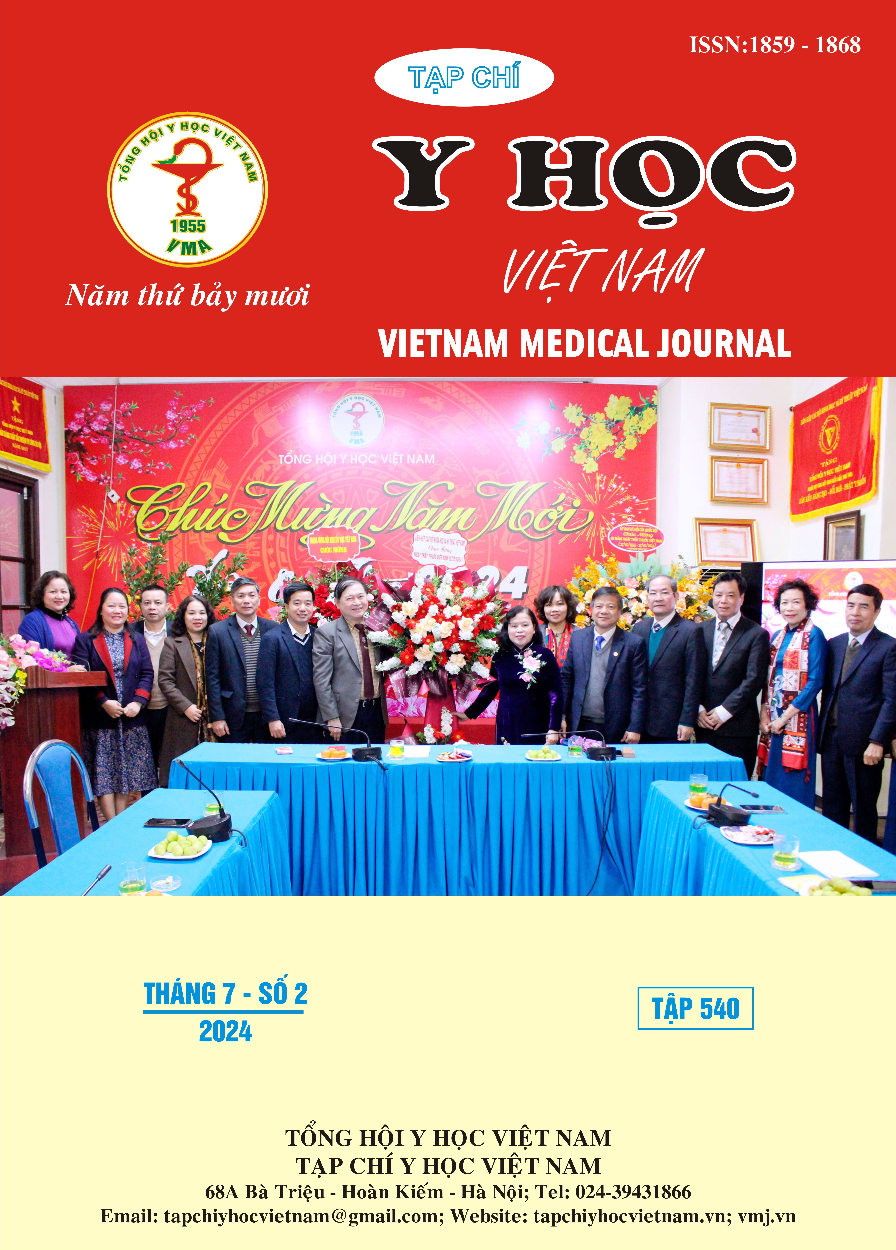ĐÁNH GIÁ KẾT QUẢ ĐIỀU TRỊ VÀ CÁC YẾU TỐ LIÊN QUAN ĐẾN TỬ VONG Ở TRẺ SƠ SINH SINH NON DƯỚI 32 TUẦN TẠI KHOA NHI – SƠ SINH BỆNH VIỆN PHỤ SẢN THÀNH PHỐ CẦN THƠ NĂM 2023-2024
Nội dung chính của bài viết
Tóm tắt
Đặt vấn đề: Sinh non luôn phải đối mặt với rất nhiều yếu tố nguy cơ và biến chứng nặng, là nguyên nhân tử vong đứng hàng thứ 2 ở trẻ em dưới 5 tuổi và là nguyên nhân trực tiếp quan trọng nhất gây tử vong trong tháng đầu sau sinh. Mục tiêu: 1) Xác định tỉ lệ các biến chứng liên quan đến trẻ sinh non ở trẻ sơ sinh sinh non dưới 32 tuần. 2) Khảo sát các can thiệp điều trị ở trẻ sơ sinh sinh non dưới 32 tuần. 3) Xác định tỷ lệ tử vong và một số yếu tố liên quan đến tử vong ở trẻ sơ sinh sinh non dưới 32 tuần. Đối tượng và phương pháp nghiên cứu: Nghiên cứu mô tả cắt ngang 140 trẻ sơ sinh non tháng dưới 32 tuần tại Bệnh viện Phụ sản Thành phố Cần Thơ từ tháng 02/2023 đến 03/2024. Kết quả nghiên cứu: Giới tính nam chiếm 57,9%, tuổi thai trung bình 29,95 ± 1,96 tuần, cân nặng trung bình 1275 ± 358g. Tỷ lệ các biến chứng liên quan đến sinh non: bệnh màng trong (93,6%), cơn ngưng thở (98,6%,) viêm phổi bệnh viện (42,9%,) nhiễm trùng sơ sinh sớm (28,6%,) nhiễm trùng huyết muộn (27,1%), PDA cần can thiệp điều trị bằng thuốc (23,6%), viêm ruột hoại tử từ độ II (20,0%), loạn sản phế quản phổi (17,1%), hạ đường huyết (15,0%), xuất huyết não (13,6% ) và 7,1% ROP có chỉ định điều trị, 5,0% có xuất huyết phổi và có 2,1% tràn khí màng phổi. Tỷ lệ các can thiệp điều trị: Có 99,3% trẻ cần can thiệp hồi sức sau sinh, trong đó 90% can thiệp hồi sức bằng NCPAP, 94,3% cần điều trị bằng NCPAP và 21,4% thở máy trong thời gian điều trị, 35,7% bơm surfactant, 95,8% cần dinh dưỡng tĩnh mạch hoàn toàn, 40% cần truyền hồng cầu lắng. Tỷ lệ thành công 87,2%, tử vong 7,1%, tỷ lệ tử vong của các nhóm tuổi thai sinh non < 26 tuần, 26 -< 28 tuần, 28 -< 30 tuần và 30 -< 32 tuần lần lượt là 55,6%, 0%, 5,0% và 4,3%. Nuôi sống thành công tuổi thai thấp nhất là 24,6 tuần, CNLS 680g. Các yếu tố làm tăng nguy cơ tử vong của trẻ: tuổi thai < 28 tuần OR =4,08, KTC 95% = 1,09-15,25, p=0,041, CNLS < 1000g OR =6,82, KTC 95% = 1,77-26,21, p=0,006, bệnh màng trong độ 3-4 OR =4,78, KTC 95% = 1,17-19,48, p=0,034, nhiễm trùng huyết muộn OR =31,67, KTC 95% = 3,84-261,13, p<0,001, xuất huyết phổi OR =60, KTC 95% = 9,27-388,51, p=0,001, viêm ruột hoại tử OR =6,18, KTC 95% = 1,62-23,62, p=0,012 và xuất huyết não OR =11,2, KTC 95% = 2,77-45,34, p=0,002. Kết luận: Tỷ lệ sinh non nhập viện với chẩn đoán bệnh màng trong cao. Tỷ lệ các biến chứng liên quan đến sinh non như bệnh màng trong, viêm phổi bệnh viện, nhiễm trùng huyết cao. Tỷ lệ tử vong ở nhóm < 26 tuần còn cao. Yếu tố liên quan tử vong chủ yếu là tuổi thai < 28 tuần, CNLS < 1000g, bệnh màng trong độ 3-4, nhiễm trùng huyết muộn, xuất huyết phổi, viêm ruột hoại tử và xuất huyết não.
Chi tiết bài viết
Từ khóa
sinh non, sinh non và biến chứng, tử vong sinh non.
Tài liệu tham khảo
2. Lê Nguyễn Nhật Trung, Lê Thị Thùy Dung, Trần Trọng Phương Trừ (2016), "Kết quả điều trị trẻ sơ sinh sinh non 26 - 34 tuần tuổi thai tại Bệnh viện Nhi đồng 2", Y học TP. Hồ Chí Minh, 20 (2), pp. 30-36.
3. Trương Quang Hưng, Hoàng Thị Diễm Tuyết (2018), “Khảo sát các yếu tố liên quan đến nguy cơ tử vong sơ sinh sớm của trẻ ở tuổi thai 28-32 tuần tại bệnh viện Hùng Vương”, Y học TP.Hồ Chí Minh, 22 (1), pp.49-54
4. Phạm Thị Thanh Tâm, Nguyễn Thanh Nguyên (2017), "Tỉ lệ tử vong và chi phí điều trị trẻ sơ sinh non tháng nhẹ cân suy hô hấp tại khoa HSSS-BVNĐ 1", Y học TP. Hồ Chí Minh, 21 (4), pp. 54-61.
5. Phạm Thị Thanh Tâm, Nguyễn Thu Tịnh (2019), "Tử vong, biến chứng và chi phí điều trị trẻ sơ sinh có tuổi thai cực thấp tại khoa HSSS-BVNĐ 1", Y học TP. Hồ Chí Minh, 23 (4), pp. 59-66
6. Ngô Minh Xuân, Lê Thị Cẩm Giang, Nguyễn Thì Từ Anh (2019), "Hiệu quả của kỹ thuật bơm surfactant ít xâm lấn", Y Học TP. Hồ Chí Minh, 23 (3), tr. 283-291.
7. Bolisetty Srinivas, Legge Nele, Bajuk Barbara, et al. (2015), "Preterm infant outcomes in New South Wales and the Australian Capital Territory", 51 (7), pp. 713-721.
8. Fetus Committee on, Newborn, Barfield Wanda Denise, et al. (2012), "Levels of neonatal care", 130 (3), pp. 587-597.
9. Jo Heui Seung, Cho Kee Hyun, Cho Sung-Il, et al. (2015), "Recent changes in the incidence of bronchopulmonary dysplasia among very-low-birth-weight infants in Korea", 30 (Suppl 1), pp. S81-S87.
10. Lawn Joy E, Davidge Ruth, Paul Vinod K, et al. (2013), "Born too soon: care for the preterm baby", 10 (1), pp. 1-19


